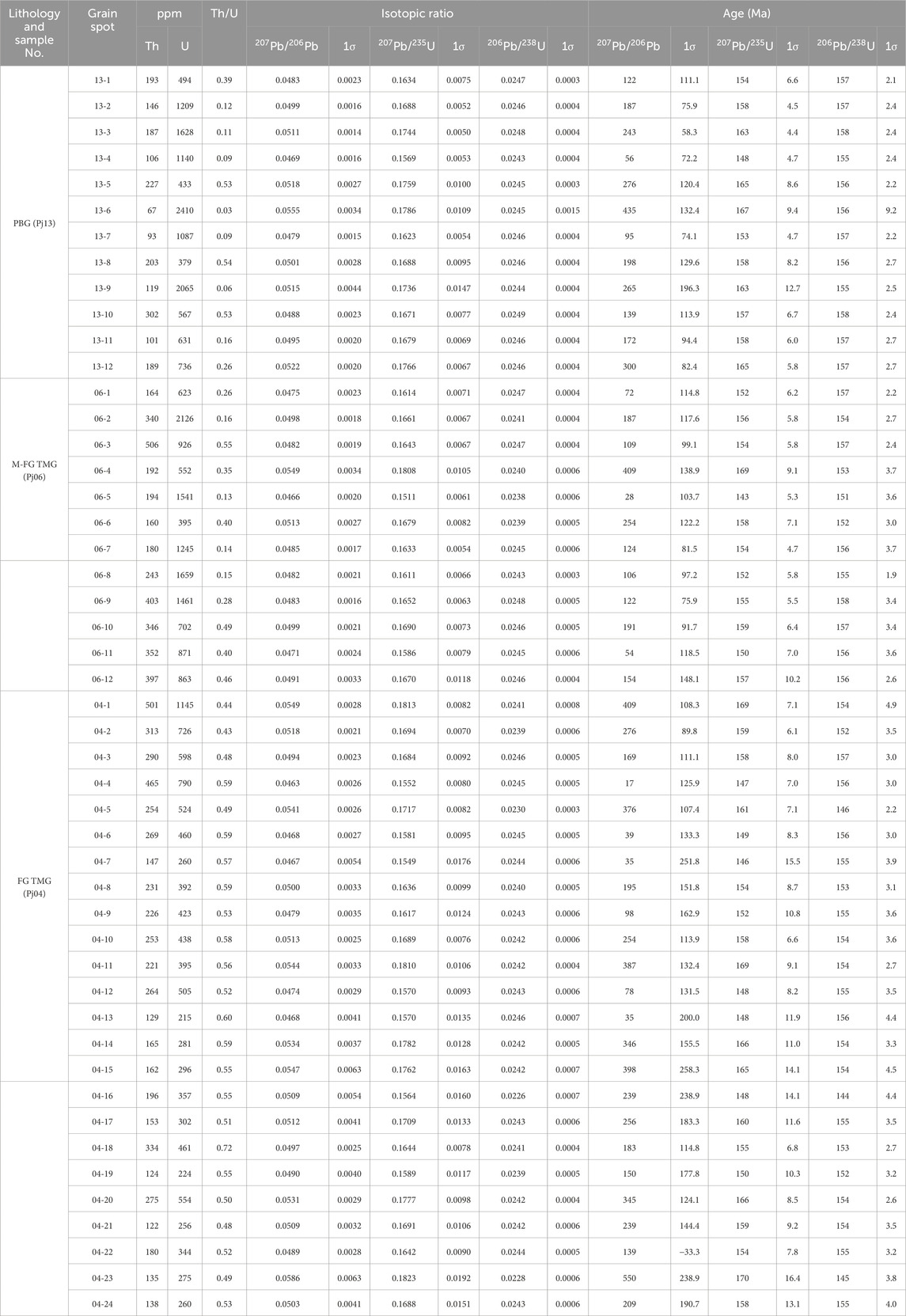- 1College of Nuclear Technology and Automation Engineering, Chengdu University of Technology, Chengdu, China
- 2Applied nuclear technology of in Geosciences key laboratory of Sichuan province, Chengdu university of technology, Chengdu, China
- 3Research Institute No. 290, China National Nuclear Corporation, Shaoguan, China
- 4State Key Laboratory for Mineral Deposits Research, School of Earth Sciences and Engineering, Nanjing University, Nanjing, China
- 5Research Institute Shaanxi Yanchang Petroleum (Group) Co., Ltd., Xi’an, China
- 6School of Earth Sciences and Resources, China University of Geosciences, Beijing, China
The E–W-striking Fogang granitic batholith represents the largest composite batholith in Guangdong Province. To date, the only known uranium deposit, the Pajiang deposit, has been identified in the southwestern portion of the Fogang granitic batholith. This deposit is hosted by porphyritic biotite granite (PBG) and two-mica granites. Nevertheless, the age, petrogenesis, and genetic relationships between these lithologies and the associated uranium mineralization remain subjects of ongoing debate. In this study, zircon U–Pb dating, whole-rock geochemistry, and zircon trace-element analyses of porphyritic biotite granite and two-mica granites in the Pajiang area of the Fogang granitic batholith were systematically investigated. The results reveal that the geochronologies of the porphyritic biotite granite, medium-to-fine-grained two-mica granite (M-FG TMG), and fine-grained two-mica granite (FG TMG) are 156.7 ± 0.7 Ma (MSWD = 0.2, n = 11), 155.3 ± 1.6 Ma (MSWD = 0.5, n = 12), and 153.8 ± 1.4 Ma (MSWD = 0.6, n = 24), respectively. The porphyritic biotite granite is characterized by high SiO2, high alkalis, and a metaluminous to peraluminous composition (A/CNK = 0.95–1.21; mean = 1.08) but low rare earth contents (∑REE: 107 ppm–465 ppm, mean = 183 ppm) and negative Eu anomalies (δEu = 0.12–0.60, mean = 0.29), indicative of a highly fractionated S-type granite. The porphyritic biotite granite, medium-to-fine-grained two-mica granite, and fine-grained two-mica granite all show high Rb/Sr values (1.52–41.7, with a mean of 8.76), indicating derivation from mature continental crust material. The porphyritic biotite granite has CaO/Na2O ratios of 0.06–0.70, suggesting that its source was a mixture of pelitic and clastic rocks. The medium-to-fine-grained two-mica granite and fine-grained two-mica granite have lower CaO/Na2O ratios, indicating derivation from predominantly pelitic sources. Zircon trace-element data indicate that the porphyritic biotite granite has a relatively higher oxygen fugacity (fO2 = −13.2), followed by the medium-to-fine-grained two-mica granite and the fine-grained two-mica granite, which exhibit relatively lower oxygen fugacities (fO2 = −20.2 and −17.3, respectively). Under low-oxygen-fugacity conditions, uranium tends to crystallize as independent uranium-bearing minerals or uranium-rich minerals during the magmatic stage; in contrast, under high-oxygen-fugacity conditions, uranium is more likely to be incorporated into refractory accessory minerals (e.g., zircon and monazite). The crystallization processes of the medium-to-fine-grained two-mica granite and the fine-grained two-mica granite are thus particularly favorable for the formation of uranium-bearing minerals such as uraninite and thorite. These minerals are susceptible to dissolution by hydrothermal fluids during subsequent Late Cretaceous uranium mineralization, thereby releasing uranium and providing a substantial source for mineralization. This further suggests that the two-mica granites serve as significant uranium source rocks for granite-type uranium deposits and hold favorable implications for mineral exploration.
1 Introduction
In northern Guangdong, there are three nearly east–west-trending granite belts (Figures 1A,B), which, from north to south, are the Zhuguang–Jiufeng granite belt, the Guidong–Dadongshan granite belt, and the Fogang–Xinfengjiang granite belt (Shu et al., 2006). Many granite-hosted uranium deposits, such as those in the Chengkou, Changjiang, Baishun, and Xiazhuang uranium ore fields, have been found in the Zhuguang–Jiufeng and Guidong–-Dadongshan granite belts (Li et al., 2024a). Spatially, these uranium deposits are closely associated with granites, with mineralization distributed both within and along the margins of granitic intrusions.
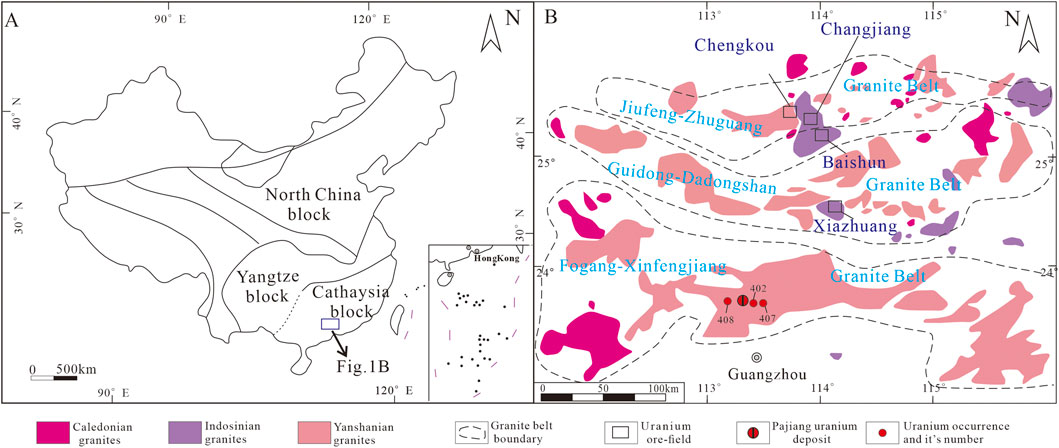
Figure 1. (A) Geotectonic position; (B) distribution map of east–west-trending granite belts, northern Guangdong (modified after Zhou, 2007).
Granite-hosted uranium deposits in South China predominantly occur within S-type granites, particularly those formed through crustal anatexis during the Triassic and Jurassic periods, with subordinate occurrences in A-type granites. These granitoids are typically enriched in uranium-bearing minerals such as uraninite, which act as the critical metal source for subsequent mineralization events (Tao et al., 2025). Extensive evidence indicates that oxidative meteoric waters effectively leach uranium from uranium-bearing or uranium-rich minerals through fluid–rock interactions, thereby facilitating uranium mobilization and enrichment (Chabiron et al., 2003; Cuney, 2009; Qiu et al., 2015; 2018; Zhang L. et al., 2018; 2021a; Zhang et al., 2019). Economically significant uranium deposits are notably concentrated within large composite batholiths characterized by multiphase and multi-stage emplacement histories (Zhang et al., 2021b; Fan et al., 2023). A critical unresolved issue pertains to identifying which specific phase or emplacement stage within these composite plutons served as the principal uranium source for mineralization or whether the entire composite body contributed uniformly to the uranium endowment. Addressing this question is essential for accurately delineating ore-body distributions and refining exploration strategies. Consequently, systematic investigations aimed at pinpointing the uranium-contributing phase or stage within composite granite plutons represent a key research priority.
The Fogang granitic batholith, a major constituent of the “Fogang–Xinfengjiang Granite Belt,” spans an area of approximately 6,000 km2, making it the largest composite batholith within Guangdong Province (Chen et al., 2002; Xu et al., 2007; Guo and Huang, 2019; Ding et al., 2022). This extensive batholith is primarily composed of porphyritic biotite granite (PBG), medium-to-fine-grained two-mica granite (M-FG TMG), and fine-grained two-mica granite (FG TMG). Previous geological surveys (Guangdong Bureau of Geology and Mineral Resources, Team No.705, 1983; Li et al., 2024b) in the southwestern part of the Fogang granitic batholith have identified the Pajiang uranium deposit, three uranium occurrences (No. 402, 407, and 408; Figure 1B), and multiple anomalous zones, highlighting the considerable potential of the batholith for uranium exploration. However, significant uncertainties remain concerning the formation age, magmatic evolution sequence, and polyphase or multi-stage development of these granitic bodies. Additionally, the specific lithological units responsible for supplying uranium to the identified deposits have yet to be clearly determined. As variations in uranium fertility among different intrusive phases may critically influence the scale of mineralization, it is essential to systematically constrain the temporal evolution of PBG, M-FG TMG, and FG TMG within the Fogang granitic batholith through integrated geochronological and petrochemical investigations. These constraints significantly enhance metallogenic models and exploration targeting efficiency. Controversy also persists regarding the petrogenetic classification of the Fogang granitic batholith. Some scholars, through analyses of trace elements, rare earth elements (REEs), and Sr–Nd–Hf isotopes of the PBG, suggest that it has an I-type affinity (Li et al., 2007; Chen and Yang, 2015). In contrast, other researchers argue for an S-type origin based on analyses of elemental geochemistry and Sr–Nd–Pb–O isotopes (Chen et al., 2002). Therefore, further geochemical and geochronological investigations are essential to resolve this debate and establish a more robust genetic framework for the batholith.
This study, leveraging petrology, zircon U–Pb chronology, geochemistry, and zircon trace element analyses, aims to constrain the formation ages, magmatic evolution, and petrogenetic type of these granitic units. By establishing the link between magmatic processes (e.g., oxygen fugacity variations) and uranium mineralization potential across different granitic units, this study aims to identify which lithologies (e.g., PBG, M-FG TMG, and FG TMG) serve as primary uranium sources. This, in turn, will refine metallogenic models for granite-type uranium deposits in the region, enabling more targeted and efficient prospecting.
2 Geological setting
The Fogang granitic batholith (23°30′–24°10′N, 113°00′–114°20′E), which is primarily controlled by the Fogang–Fengshun and Enping–Xinfeng faults (Figures 2A,B), extends in an east–west direction along the Fogang–Heyuan region. It spans approximately 140 km in length and 40 km in width. This batholith, a multi-stage composite granitic body (Chen et al., 2002), is primarily composed of PBG, M-FG TMG, and FG TMG in the Pajiang area (Figure 2B). Among these, PBG exhibits the widest exposure, intruding into Devonian and Jurassic strata, while M-FG TMG and FG TMG show relatively smaller exposures.
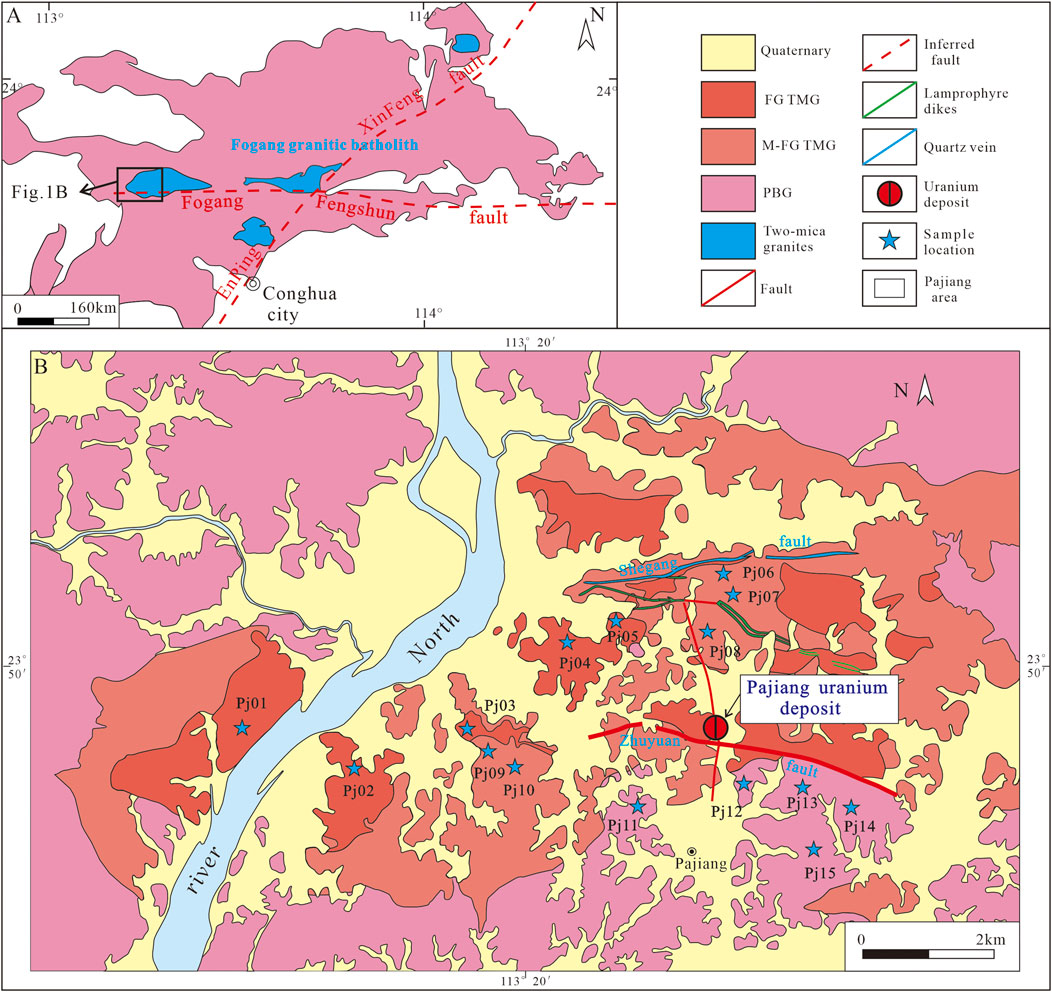
Figure 2. (A) Geological sketch map of the Fogang granitic batholith. (B) Geological sketch map of the Pajiang area.
Since the 1950s, the Pajiang uranium deposit and multiple uranium occurrences have been identified within the Fogang granitic batholith. The Pajiang deposit is situated in the southwestern portion of the Fogang granitic batholith, with its host rocks comprising FG TMG and M-FG TMG. The deposit is structurally controlled by prominent fault systems, notably the nearly east–west-trending Shegang fault and Zhuyuan fault, which exhibit evidence of complex stress regimes, including extensional, compressional, and torsional deformation (Li et al., 2024b; Xu, 2024). These major faults functioned as key ore-guiding structures, facilitating the migration of hydrothermal fluids. In addition to these primary faults, secondary fractures trending sub-NW–SE and nearly N–S are extensively developed within the shear zones. Hydrothermal alteration is pervasive, encompassing silicification, hematitization, sericitization, dark purple fluoritization, pyritization, and chloritization. Among these, silicification—characterized by dark red microcrystalline quartz—along with dark purple fluorite and cloudy hematitization, shows a strong spatial and genetic association with uranium mineralization (Li et al., 2024b). The primary ore minerals include pitchblende and minor coffinite, whereas the gangue minerals are dominated by quartz, pyrite, and dark purple fluorite.
3 Petrography
In this study, fresh granite samples from the Pajiang area were analyzed using petrological and mineralogical methods. The primary rock types identified are PBG, M-FG TMG, and FG TMG.
The PBG is grayish-white with massive structures and is mainly composed of quartz (25–27 wt%), K-feldspar (45–48 wt%), plagioclase (16–20 wt%), and biotite (7–9 wt%, Figure 3A). The quartz is grayish-white and euhedral in shape, mostly over 5 mm in size, and locally encloses zircon and other accessory minerals (Figures 3A,B). K-feldspar is mainly euhedral–subhedral in shape, predominantly microcline, developing lattice double crystals and stripe structures (Figure 3C), and is slightly altered by sericitization. Plagioclase is grayish-white with euhedral–subhedral shapes, exhibiting albite twinning, An = 28, partly altered by sericitization. Biotite is brown, flaky, 2–5 mm in size, and exhibits pale yellow to yellow–brown pleochroism. The accessory minerals include zircon, apatite, and allanite, among which allanite is relatively more enriched (Figure 3C).
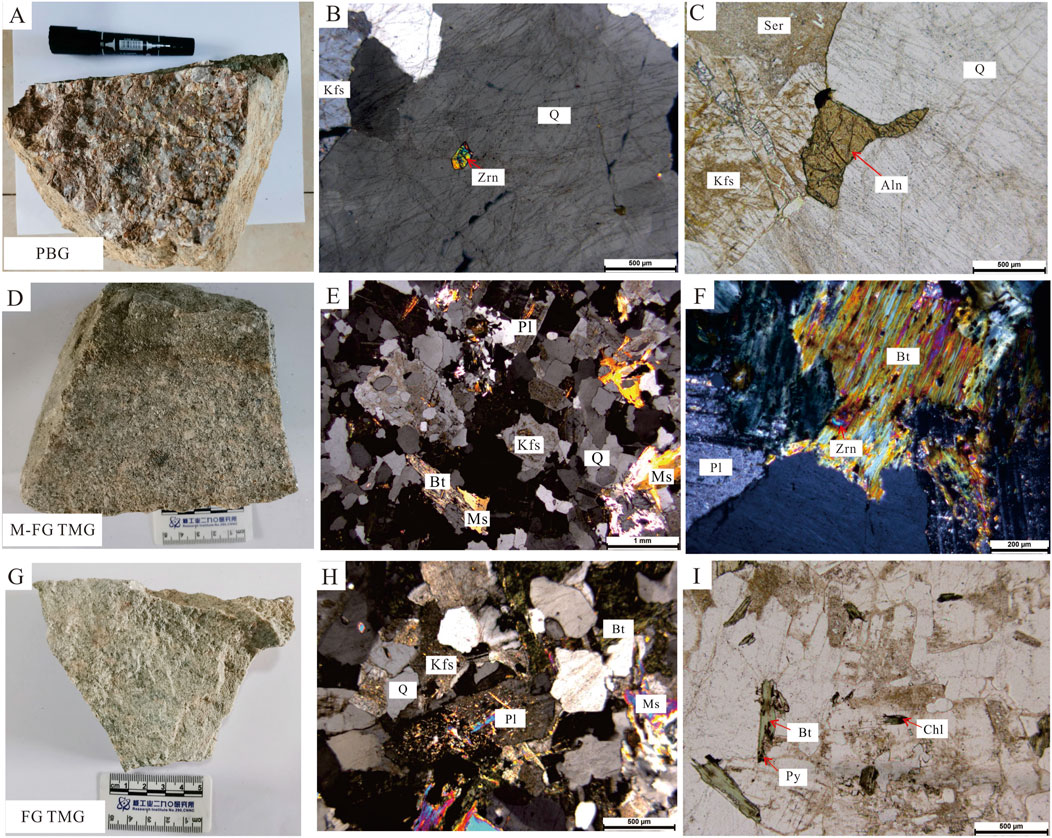
Figure 3. Hand specimens and photomicrographs of rocks from the Fogang granitic batholith in the Pajiang area. (A) Hand specimens of PBG; (B) Coarse-grained quartz enclosing zircon in PBG (Cross-polarized light); (C) Sericitization developed in K-feldspar (Plane-polarized light); (D) Hand specimens of M-FG TMG; (E) Photomicrographs of M-FG TMG (Cross-polarized light); (F) Zircon enclosed in biotite (Cross-polarized light); (G) Hand specimens of FG TMG; (H) Photomicrographs of FG TMG (Cross-polarized light); (I) Chloritization of biotite (Plane-polarized light). Q, quartz; Kfs, feldspar; Pl, plagioclase; Bt, biotite; Ms, muscovite; Chl, chlorite; Ser, sericite; Zrn, zircon; Py, pyrite; Aln, allanite.
The M-FG TMG is grayish-white with a massive structure (Figure 3D). It is mainly composed of quartz (25–28 wt%), K-feldspar (44–48 wt%), plagioclase (15–20 wt%), biotite (5–6 wt%), and muscovite (5–6 wt%). Quartz is grayish-white and euhedral in shape, with a particle size of 1–4 mm, and exhibits undulatory extinction locally (Figure 3E). K-feldspar is predominantly euhedral to subhedral in form, with a grain size of 2–4 mm, and exhibits slight alteration by sericitization (Figure 3E). Plagioclase also appears mainly as euhedral to subhedral crystals, often occurring in clustered twin forms, and shows alteration by sericitization and muscovitization (Figures 3E,F). Biotite, typically ranging from 1 to 3 mm in size, is partially altered to chlorite and locally encloses certain accessory minerals, such as zircon (Figure 3F). The accessory minerals include zircon and apatite.
The FG TMG, exhibiting a massive structure (Figure 3G), is primarily composed of quartz (25–27 wt%), K-feldspar (45–48 wt%), plagioclase (16–18 wt%), biotite (4–5 wt%), and muscovite (4–5 wt%). Quartz is grayish-white and euhedral in shape, and its particle size is 1–2 mm (Figure 3H); K-feldspar is mainly euhedral–subhedral in shape, developing lattice double crystals, and is slightly altered by sericitization (Figure 3H). Plagioclase is mainly euhedral–subhedral in shape and is altered by sericitization and muscovitization (Figure 3H). Biotite, with a size of 1–2 mm, is partly altered by chlorite and is commonly associated with pyrite (Figure 3I). The accessory minerals, such as zircon and apatite, can be found locally.
4 Sampling and analytical methods
In this study, five FG TMG samples (Pj01–Pj05), five M-FG TMG samples (Pj06–Pj10), and five PBG samples (Pj11–Pj15) were collected from the Pajiang area for zircon separation and geochemical analysis.
Laser ablation inductively coupled plasma mass spectrometer (LA-ICP-MS) analysis, zircon U–Pb dating, and trace element analysis were carried out on the collected samples from the Pajiang area. Zircon crystals were separated from bulk rock samples using standard magnetic and density separation techniques, followed by manual extraction under a binocular microscope. The selected zircon grains were embedded in an epoxy mount. Prior to analysis, cathodoluminescence (CL) and backscattered electron (BSE) imaging were conducted at the Wuhan Sample Solution Analytical Technology Company to characterize internal textures and identify suitable target sites for U–Pb isotopic analysis. Zircon U–Pb isotope analysis was carried out via LA-ICP-MS at the Wuhan Sample Solution Analytical Technology Company, using an Agilent 7900 instrument. A 32 μm spot size was adopted in this study. Helium was used as the carrier gas to increase the transport efficiency of the ablated material. Data were acquired for 20 s with the laser off and 40 s with the laser on. Glass NIST610 was used as the external calibration standard, while Zircon 91500 served as the internal standard for U–Pb dating and trace element calibration (Hu et al., 2015), respectively. The ages and concordia diagrams were prepared using ISOPLOT 3.0 (Ludwig, 2003).
Major oxide concentrations were determined using a PANalytical (formerly Philips) PW 2424 X-ray Fluorescence (XRF) Spectrometer at American Laboratory Services Chemex (Guangzhou) Company Limited, China, with analytical uncertainties controlled within ≤ 2 wt%. Trace and REE contents were analyzed at the same facility using an Agilent 7900 Quadrupole Inductively Coupled Plasma Mass Spectrometer. Approximately 50 mg of each powdered rock sample was utilized for trace element analysis. All samples underwent digestion in distilled HF and HNO3 within Teflon screw-cap capsules at 190 °C for 72 h, followed by drying and a secondary digestion in HNO3 at 150 °C for 24 h. The final step was repeated once. The dissolved samples were diluted to 49 mL with 3 wt% HNO3 and 1 mL of 500 ppb. Rh was added to the solution as an internal standard. The analytical uncertainties for trace elements and REE were generally lower than 10 wt%.
5 Results
5.1 U–Pb zircon ages and zircon Ti–temperature calculations
The zircon grains from the three types of granite are mostly euhedral, transparent, and colorless. CL imaging reveals distinct core–rim structures with well-defined oscillatory zoning growth bands (Figure 4). The Th/U ratios of zircon in PBG, M-FG TMG, and FG TMG range from 0.03 to 0.54 (mean = 0.24), 0.13 to 0.55 (mean = 0.31), and 0.43 to 0.72 (mean = 0.54), respectively (Table 1), indicating a magmatic origin (Li et al., 2014; Yang et al., 2024).
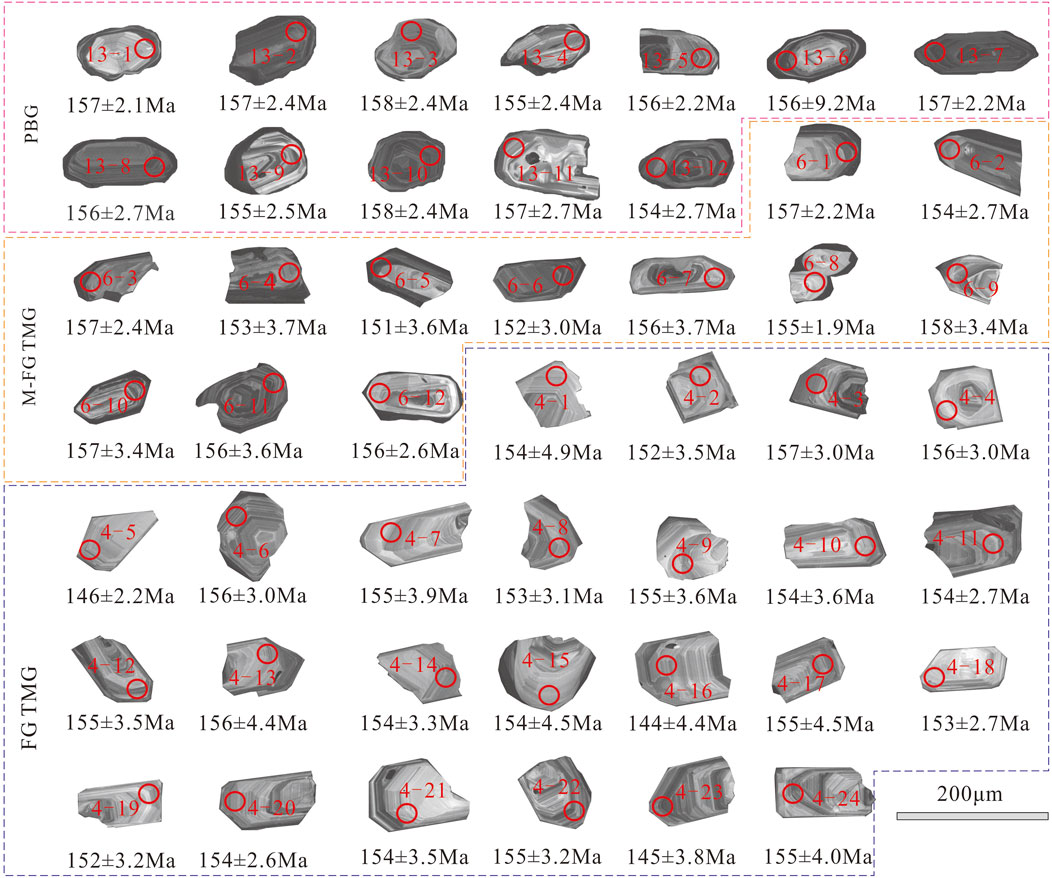
Figure 4. Cathode luminescence images of zircon grains from the granites in the Fogang granitic batholith.
A total of 12 spots in the PBG samples were analyzed (Table 1). The results indicate that the 206Pb/238U and 207Pb/235U ages are mostly concordant, with all spots lying on the concordia line. A data point to the right of the concordia line was excluded as its deviation was likely due to Pb loss. The remaining 11 data points show that the 206Pb/238U ages mainly range from 155 to 158 Ma. The analyzed grains yield a weighted mean 206Pb/238U age of 156.7 ± 0.7 Ma (MSWD = 0.2, n = 11) (Figures 5A,B), indicating the product of Yanshanian magmatic activity.
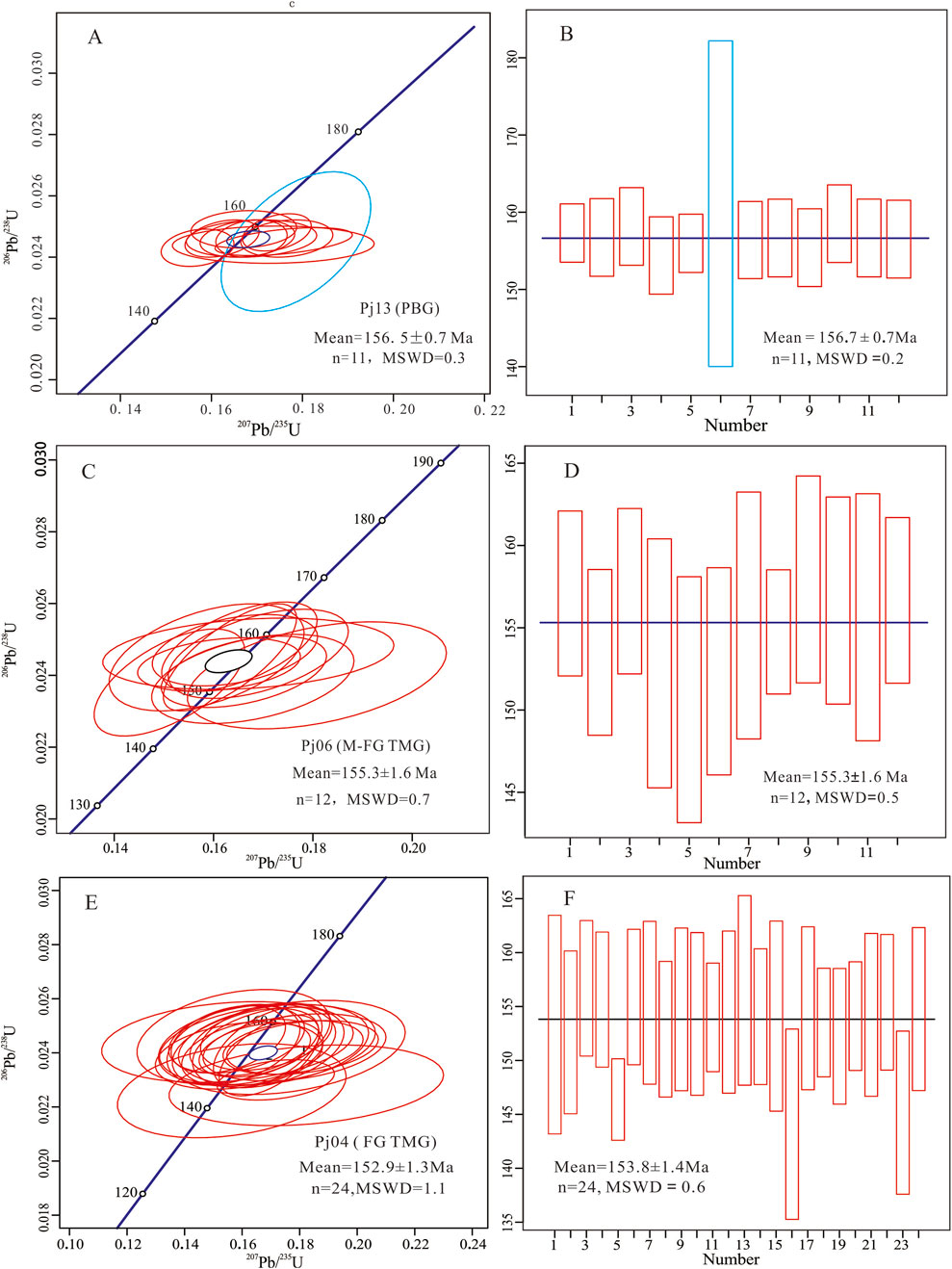
Figure 5. U–Pb concordia diagrams of zircons from the granites in the Fogang granitic batholith. (A) Concordant age of PBG; (B) 206Pb/238U average age of PBG; (C) Concordant age of M-FG TMG; (D) 206Pb/238U average age of M-FG TMG; (E) Concordant age of FG TMG; (F) 206Pb/238U average age of FG TMG.
A total of 12 spots of M-FG TMG zircons were analyzed, with all data points lying on the concordia line. Furthermore, 206Pb/238U ages were concentrated in the range of 151–158 Ma, with a weighted average age of 155.3 ± 1.6 Ma (MSWD = 0.5, n = 12) (Figures 5C,D). A total of 24 spots in the FG TMG samples were analyzed, and the 206Pb/238U ages were concentrated in the range of 144–157 Ma, with a weighted mean 206Pb/238U age of 153.8 ± 1.4 Ma (MSWD = 0.6, n = 24) (Figures 5E,F). The ages of the M-FG TMG and FG TMG are consistent with those of the PBG, indicating the product of contemporaneous intrusion magmatism.
Additionally, the relationship between zircon Ti content and temperature was utilized, using the formula logTi (ppm) = (5.711 ± 0.072)– (4800 ± 86)/T (K) –logαSiO2 + logαTiO2 (Ferry and Watson, 2007),where T is the temperature in Kelvin, and Ti is the content of titanium in zircon. Owing to the occurrence of quartz and rutile as independent minerals in rocks, with αSiO2 ≈ 1 and αTiO2 ≈ 0.6 (Li et al., 2021; Li et al., 2022), zircon Ti–temperature calculations indicate that the PBG has a crystallization temperature range of 622 °C–775 °C, with an average of 714 °C (Table 2). The M-FG TMG and FG TMG exhibit crystallization temperature ranges of 594 °C–821 °C and 712 °C–842 °C, with average temperatures of 709 °C and 755 °C, respectively.
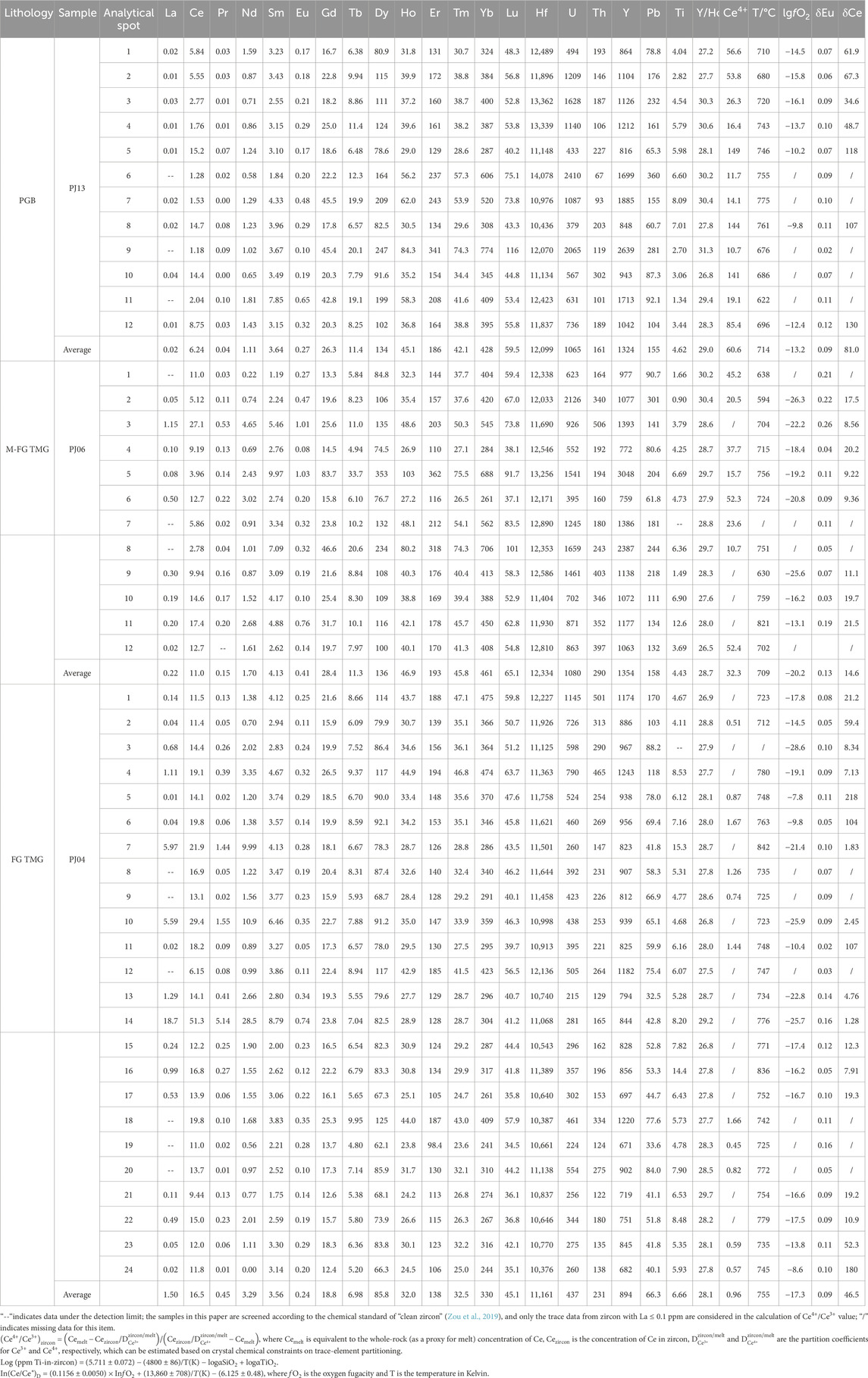
Table 2. Trace elements (ppm) and characteristic values of trace elements in zircon after screening.
5.2 Whole-rock geochemistry
5.2.1 Major oxides
The results for the major oxides in PBG, M-FG TMG, and FG TMG are listed in Table 3. The compositions of the major oxides in these rocks are similar, with enrichments in SiO2, total alkali (K2O+ Na2O), and peraluminous characteristics but depletions in CaO, MgO, TiO2, and P2O5. The SiO2 contents range from 73.2 to 75.9 wt% (mean = 74.4 wt%). The Al2O3 contents range from 12.7 to 14.3 wt% (mean = 13.7 wt%). The K2O contents range from 4.60 to 5.52 wt% (mean = 5.21 wt%). The Na2O contents range from 2.65 to 3.32 wt% (mean = 3.01 wt%). The K2O/Na2O ratios range from 1.52 to 1.96 (mean = 1.73).

Table 3. Major oxides (wt%) and trace element (ppm) compositions of representative samples from the Fogang granitic batholith§.
In the TAS classification diagram (Figure 6A), all sample data in the Fogang granitic batholith fall in the field of granite. In the SiO2 vs. K2O diagram (Figure 6B), all sample data belong to the region of the high-K calc-alkaline and shoshonite series. In the A/CNK vs. A/NK diagram (Figure 6C), most of the sample data are distributed in the metaluminous and peraluminous granite fields, indicating that they are metaluminous to peraluminous granites.
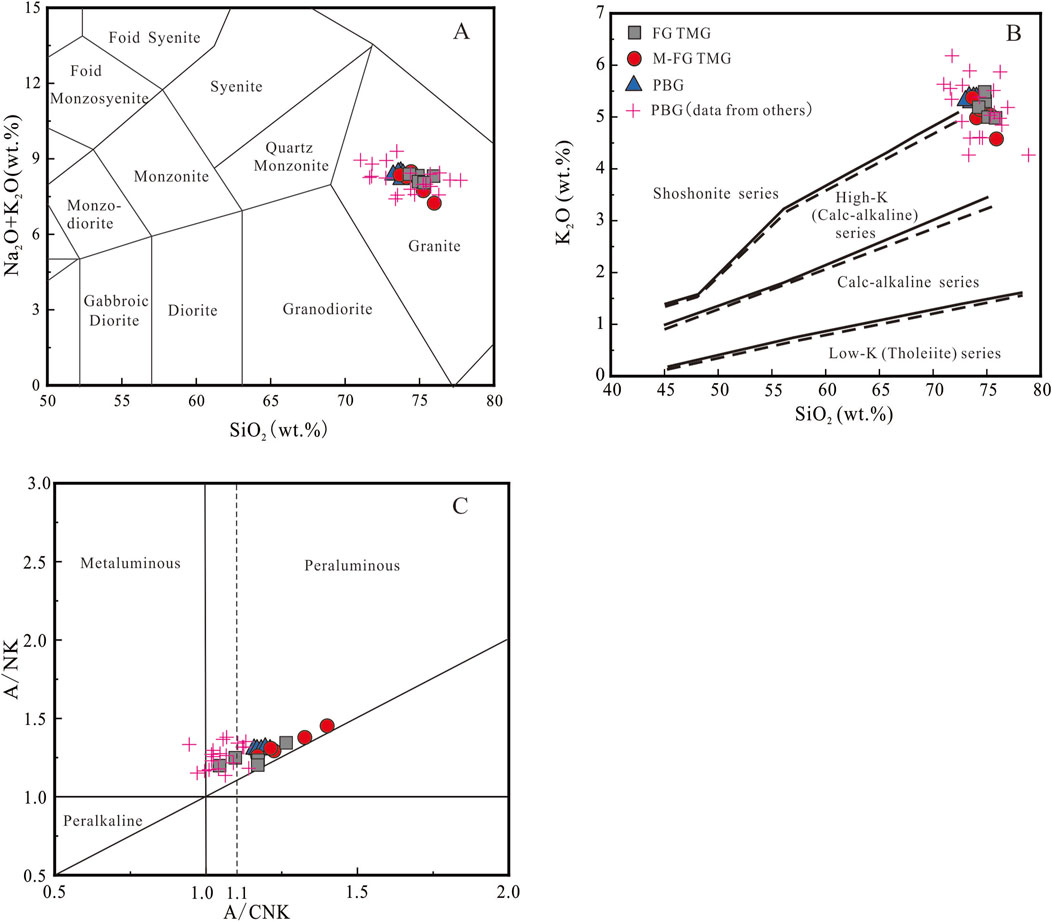
Figure 6. (A) SiO2–(K2O + Na2O) diagram (bottom panel according to the study of Middlemost, 1994); (B) SiO2–K2O diagram (bottom panel according to the study of Middlemost, 1985); (C) A/CNK–A/NK diagram (bottom panel according to the study of Maniar and Piccoli, 1989). The data on the porphyritic biotite granite published by others are from Ding et al. (2022), Li et al. (2007), Chen et al. (2002), and Ling et al. (2006); see the data in Table 3.
5.2.2 Trace element and rare earth element contents of granites
The trace element and REE contents of the PBG, M-FG TMG, and FG TMG are listed in Table 3. Their primitive mantle-normalized spider diagrams (Figure 7A) are similar, showing enrichment in Rb, Th, and U and depletion of Ba, Nb, Sr, and Ti, which are consistent with those of S-type granites (Lan et al., 2020; Xu et al., 2022). The Nb/Ta ratios of the three types of granites range from 5.25 to 7.56, below the continental crustal value (Nb/Ta = 11, Green, 1995). In the Nb vs. Nb/Ta diagram (Figure 8), both the PBG and two-mica granites plot in the field of partial melting of crustal materials, indicating that they are products of partial melting of crust-derived materials (Ballard et al., 2002; Gao et al., 2005).
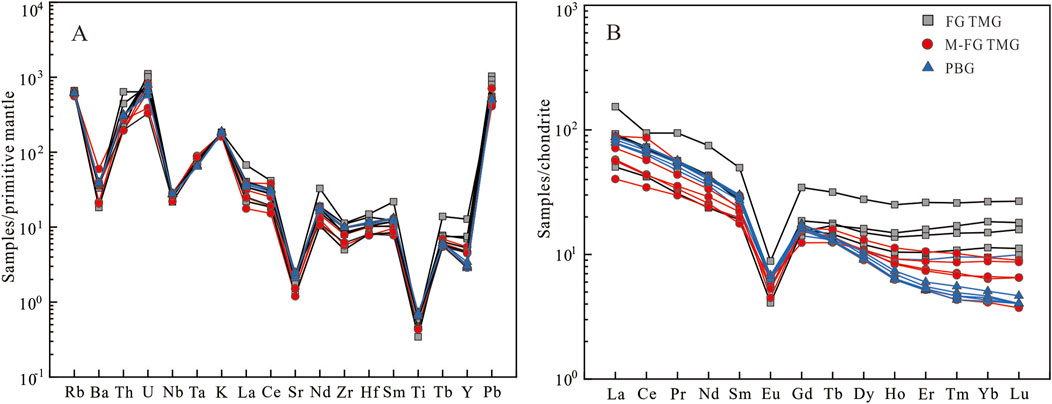
Figure 7. (A) Trace-element spider diagram and (B) chondrite-normalized REE patterns of granites in the Fogang granitic batholith. (A) Normalized data on the primitive mantle (standardized values according to the study of McDonough et al., 1991); (B) normalized data on chondrite (standardized values according to the study of Sun and McDonough, 1989).
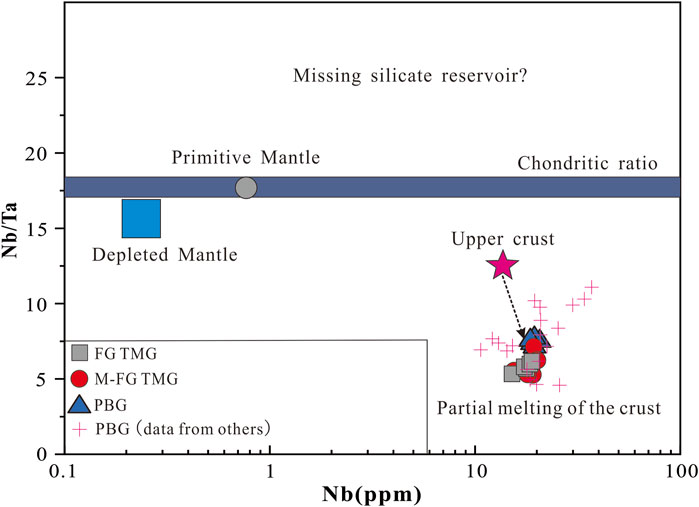
Figure 8. Plot of Nb vs. Nb/Ta (bottom panel according to the study of Barth et al., 2000). Other data sources are the same as detailed in Figure 6.
The ∑REE contents of PBG, M-FG TMG, and FG TMG are lower than those of A-type granite (∑REE = 336–346 ppm) in South China (Zhu et al., 2008), ranging from 74.8 to 224.3 ppm, with an average value of 126 ppm. The Light Rare Earth Elements/Heavy Rare Earth Elements (LREE/HREE) ratios vary between 3.70 and 13.1, indicating notable differentiation between LREE and HREE. The chondrite-normalized patterns of REE are enriched in LREE (Figure 7B). The LREE/HREE ratios gradually decrease from PBG to M-FG TMG and FG TMG (11.0 → 7.6 → 6.6), indicating a significant increase in the degree of magmatic fraction. The chondrite-normalized REE patterns exhibit pronounced negative Eu anomalies and positive Ce anomalies, with δEu values ranging from 0.21 to 0.43 and δCe values varying from 0.80 to 1.24.
5.3 Characteristics of rare earth elements in zircon
The rare earth element data of zircon are listed in Table 2. The zircon in the PBG, M-FG TMG, and FG TMG has a high total amount of rare earth elements (∑REE = 10,910–15,313 ppm). The LREE/HREE ratios vary from 0.00026 to 0.00967, indicating HREE enrichment. The chondrite-normalized REE patterns of zircons from the PBG, M-FG TMG, and FG TMG are very similar (Figure 9).
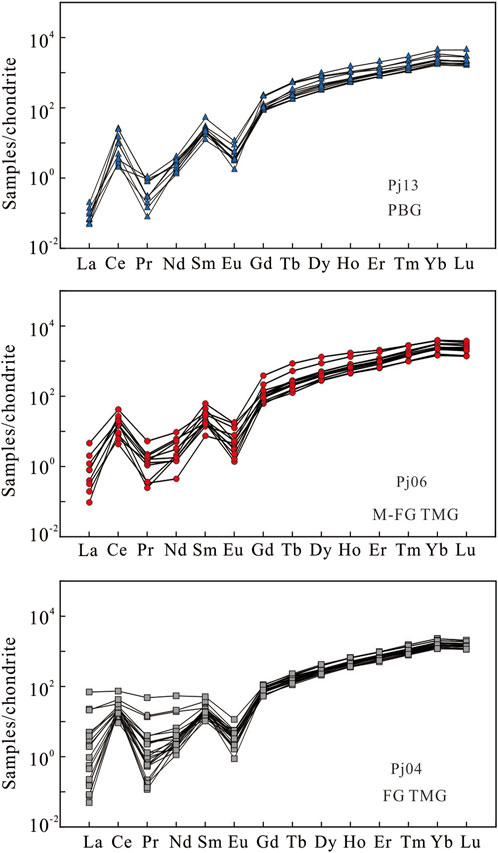
Figure 9. Chondrite-normalized REE patterns of zircons from the Fogang granitic batholith (standardized values according to the study of Sun and McDonough, 1989).
Zircons from all these rocks have positive Ce anomalies (δCe = Ce/
5.4 Zircon (Ce4+/Ce3+) oxygen fugacity barometer
Ce in zircons generally exists in the form of Ce4+ and Ce3+. In magmas with relatively high oxygen fugacity, Ce mainly exists in the form of Ce4+; because Ce4+ and Zr4+ have similar ionic radii and the same valency, a large number of Ce4+ ions easily enter zircons, resulting in positive anomalies. Therefore, the redox conditions of magma can be affected by the n (Ce4+/Ce3+) value of zircon.
Zircon data from the lattice-strain model were screened according to the La content (≤ 0.1 ppm) and the lattice-strain model deviation coefficient (δK ≤ 3) (Zou et al., 2019). After removing La-, Pr-, and Eu-sensitive elements, zircon melt partition coefficients
Additionally, Trail et al. (2011) and Trail et al. (2012) proposed a novel calibration method for determining the oxygen fugacity of magmatic melts based on Ce concentrations in zircon combined with Ti-in-zircon thermometry. This approach is expressed through the following empirical formula:
where fO2 is the oxygen fugacity. A linear relationship between the Ce anomaly and the reciprocal of temperature can be established under specific mineral oxidation buffer conditions, such as magnetite–hematite (MH), fayalite–magnetite–quartz (FMQ), and iron–wustite (IW) buffers. In the 1/T versus δCe anomaly diagram, distinct oxygen fugacity fields are delineated, allowing for the estimation of magmatic redox conditions. In the 1/T vs. δCe anomaly diagram (Figure 10), the PBG mainly falls in the region between the MH and FMQ fields, showing high oxygen fugacity with lg (fO2) values ranging from −16.1 to −9.8 (mean = −13.2). The oxygen fugacity values of M-FG TMG and FG TMG are mainly below the FMQ region, with lg (fO2) values ranging from −26.3 to −13.1 (mean = −20.2) and −28.6 to −7.8 (mean = −17.3), respectively, which are significantly lower than that of PBG.
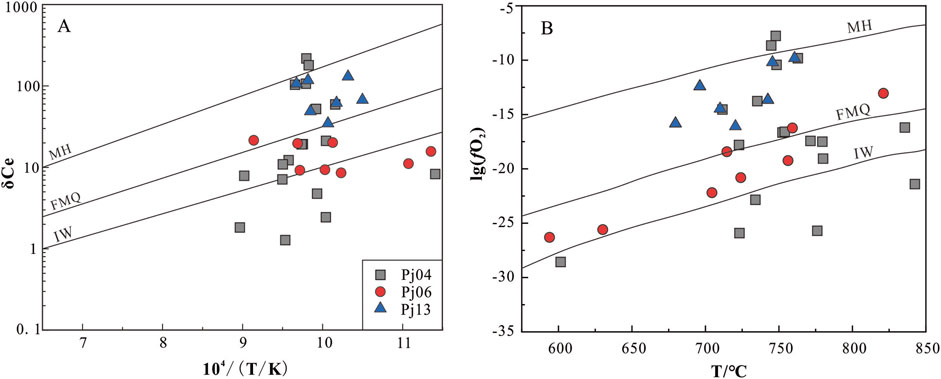
Figure 10. (A) Magma oxidation state diagram (bottom panel according to the study of Trail et al., 2011); (B) magma oxygen fugacity diagram (bottom panel according to the study of Trail et al., 2012). MH, magnetite–hematite; FMQ, fayalite–magnetite quartz; IW, iron–wuestite.
6 Discussion
6.1 Geochronology
The LA-ICP-MS zircon U–Pb age of the PBG in the Pajiang area, located in the southwestern part of the Fogang granitic batholith, is 156.7 ± 0.7 Ma (MSWD = 0.2, n = 11). This is broadly consistent with the crystallization age of 158 ± 17 Ma (MSWD = 2.79, n = 5) obtained by Bao and Zhao (2003) using the Rb–Sr method, which falls within analytical uncertainty and suggests that the Fogang granitic batholith is a product of early Yanshanian magmatic activity. Additionally, the LA-ICP-MS zircon U–Pb ages for the M-FG TMG and FG TMG are 155.3 ± 1.6 Ma (MSWD = 0.5, n = 12) and 153.8 ± 1.4 Ma (MSWD = 0.6, n = 24), respectively. These ages indicate that these granites formed during the early Yanshanian period and experienced multiple stages during the same period.
The Pajiang deposit is the only uranium deposit found in the Fogang granitic batholith. The LA-ICP-MS U–Pb dating result for the pitchblende in the deposit is 49.70 ± 0.1 Ma (MSWD = 0.16, n = 9) (Li et al., 2024b). A significant temporal discrepancy exists between the mineralization and the emplacement of the host rocks (PBG, M-FG TMG, and FG TMG), indicating that the deposit is of epigenetic hydrothermal origin. Additionally, the PBG is characterized by significant enrichment in uranium (average uranium content = 14.6 ppm) and thorium (average thorium content = 43.0 ppm). In contrast, the M-FG TMG and FG TMG exhibit higher uranium content (average 15.3 ppm) but lower thorium content (average 25.6 ppm), with Th/U ratios <3. The high U–Th characteristics of PBG may correlate with allanite (Figure 3C), which is in line with previous studies that reported significant allanite enrichment in these granites (Jayananda et al., 2000; Cuney, 2014). In contrast, the M-FG TMG and FG TMG exhibit elevated U but depleted Th contents and serve as the host rock for the Pajiang uranium deposit. It is inferred that uranium is probably present in more leachable uranium-bearing minerals, such as uraninite. Uraninite is more susceptible to leaching by later hydrothermal alteration, which could provide metallogenic material for subsequent uranium mineralization events (Qi et al., 2014; Qiu et al., 2018; Zhang et al., 2021b). This is consistent with the characteristics of granite-type uranium deposits in South China, where mineralization typically postdates the formation of the host rocks (Zhang et al., 2021b).
6.2 Petrogenetic type
In the Harker diagram (Figure 11), the PBG, M-FG TMG, and FG TMG display a pronounced negative correlation between SiO2 content and MgO, CaO, Fe2O3T, and Na2O, indicating a genetic relationship driven by magmatic evolution. The M-FG TMG and FG TMG exhibit higher differentiation indices (DI = 92.9–95.1) than the PBG (DI = 92.3–93.3). This geochemical trend, coupled with the elevated DI values, suggests that the M-FG TMG and FG TMG represent late-stage fractionated products derived from the parental magma. Given that magmatic differentiation significantly modifies the primary chemical composition, the geochemical characteristics of the M-FG TMG and FG TMG cannot be used to directly infer the original composition of the parent magma (Chen and Yang, 2015).
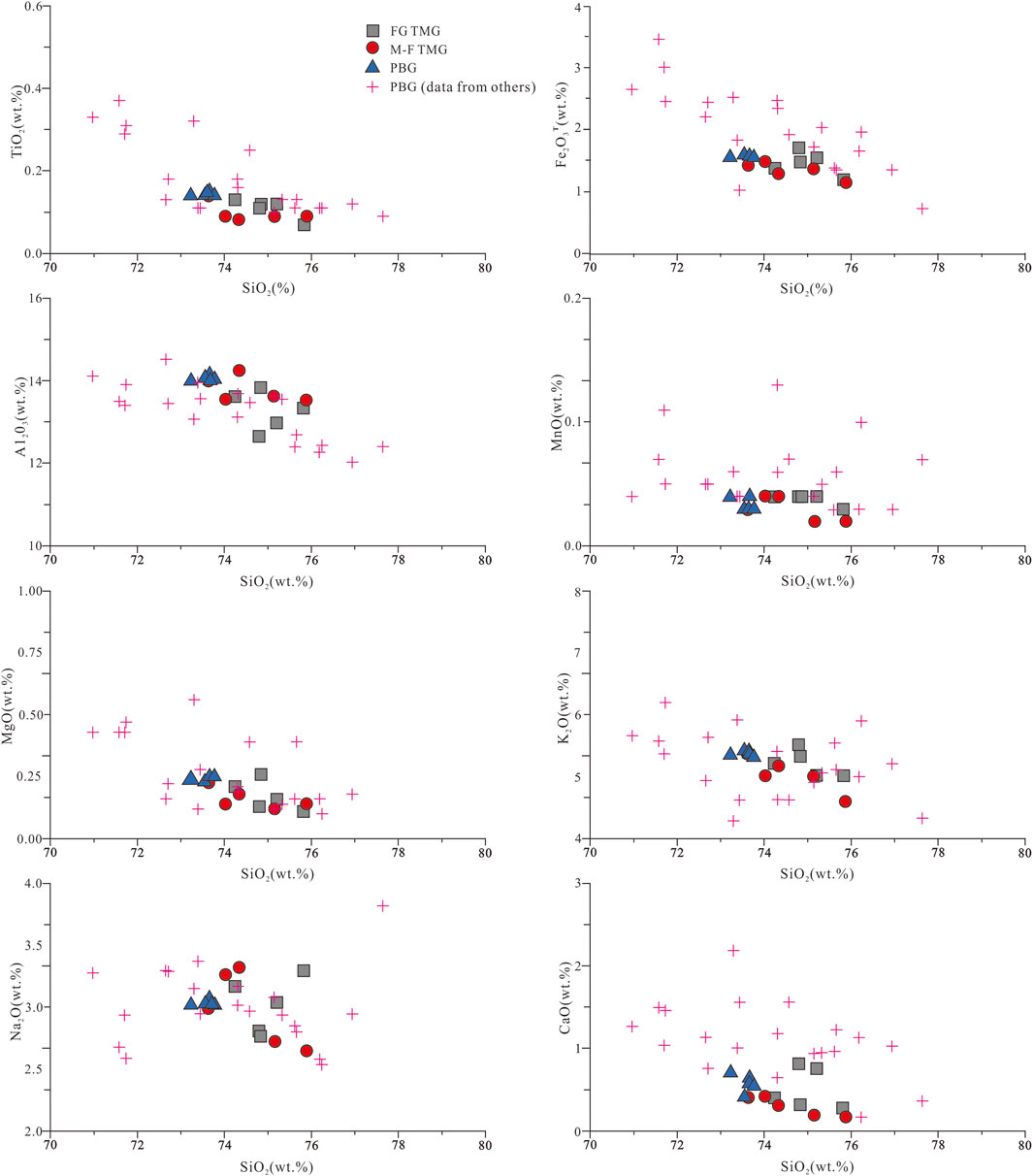
Figure 11. Harker diagram of the Fogang granitic batholith. Other data sources are the same as detailed in Figure 6.
As a result, neither M-FG TMG nor FG TMG is appropriate for constraining the petrogenetic classification of the Fogang granitic batholith. Only PBG is viable for distinguishing the petrogenetic types of the Fogang granitic batholith. A-type granites are characterized by Zr + Nb + Ce + Y > 350 ppm and Zr > 250 ppm (Whalen et al., 1987). The Zr + Nb + Ce + Y and Zr contents of the PBG in the Fogang granitic batholith range from 88 to 349 ppm and from 75.5 to 241 ppm (except for sample No. 2KSC79*, F18-1), respectively, which are significantly lower than those of A-type granites. In the 10,000 Ga/Al versus Zr diagram, data points for the PBG fall within the overlapping field of A-type granites and highly fractionated I- and S-type granites (Figure 12A). However, the zircon crystallization temperatures of this granite range from 622 °C to 775 °C, with an average of 714 °C (Table 2), which is significantly lower than the mean temperature of A-type granites (839 °C, n = 55) reported by King et al. (1997). Moreover, the total REE concentrations in this granite range from 107 to 465 ppm, with an average of 183 ppm—substantially lower than those reported for Nanling A-type granites (∑REE = 336–346 ppm) (Zhu et al., 2008). Additionally, the chondrite-normalized REE pattern of the studied granite differs markedly from that of typical A-type granites (Lan et al., 2020). Collectively, these geochemical characteristics suggest that the PBG does not represent an A-type granite but more likely corresponds to a highly fractionated I- or S-type granite (Figure 12B).
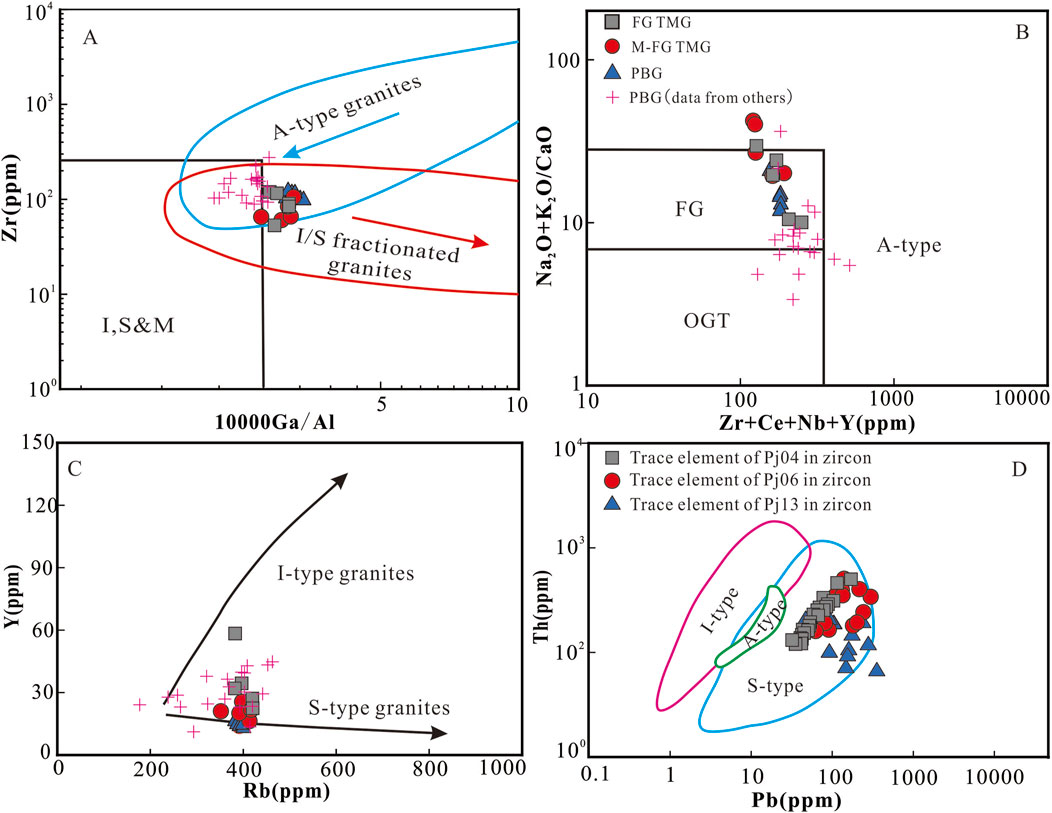
Figure 12. (A) Plot of 10000Ga/Al vs. Zr (bottom panel from the study of Wu et al., 2023); (B) plot of Zr + Nb + Ce + Y vs. (K2O+ Na2O)/CaO (bottom panel from the study of Whalen et al., 1987); (C) Plot of the Rb vs. Y diagram (bottom panel from the study of Chappell, 1999); (D) plot of the Pb vs. Th diagram for zircon (bottom panel from the study of Wang et al., 2012). Other data sources are the same as detailed in Figure 6.
Petrogenetic discrimination studies by Chappell (1999) have shown that the covariation between P2O5 and SiO2 in granites serves as a key geochemical indicator. Within his genetic classification framework, I-type granites typically display a pronounced negative correlation between P2O5 and SiO2, reflecting magmatic fractionation processes. In contrast, S-type granites exhibit no significant correlation as apatite saturation in crustal melt–residue systems constrains phosphorus behavior. In the PBG from the Fogang granitic batholith, the analytical results reveal P2O5 contents ranging from 0.02 wt% to 0.21 wt% and SiO2 contents ranging from 71.0 wt% to 77.6 wt%, with no statistically significant linear correlation observed (R2 = 0.13). This geochemical signature aligns well with the diagnostic criteria for S-type granites, indicating a crustal origin through partial melting of metasedimentary protoliths. In the Rb versus Y diagram (Figure 12C), the majority of PBG samples plot within the evolutionary field characteristic of S-type granites. The zircons from these granites exhibit elevated Pb levels (60.7–360 ppm) and pronounced negative δEu anomalies (0.02–0.12) (Table 2), which are similar to the geochemical characteristics of zircons in typical S-type granites (Wang et al., 2012; Li et al., 2021). In the Pb vs. Th plot (Figure 12D), zircon data points are also present in the S-type granite field, which further proves that the PBG are highly fractionated “S”-type granites.
6.3 Origin of granitic magma
Previous studies have demonstrated that the enrichment levels of Rb, Sr, and Nb, along with their ratios in granitic rocks, are closely related to the nature of the source rock and thus serve as valuable indicators of magma origin.
The Rb/Sr and Rb/Nb ratios of the PBG, M-FG TMG, and FG TMG range from 1.52 to 41.7 and 10.7 to 29.8, respectively, both of which are significantly higher than the corresponding values for the upper continental crust (0.32 and 4.5, respectively), as reported by Taylor and McLennan (1995). These rocks may have originated from continental crust material with high maturity. Sylvester (1998) reported that the CaO/Na2O ratios were lower than 0.30 when magma was derived from pelitic source rocks, whereas the CaO/Na2O ratios were higher than 0.30 when magma was derived from clastic source rocks. The CaO/Na2O ratios of the PBG range from 0.07 to 0.70; this broad range likely results from partial melting and mixing processes between pelitic and clastic source rocks. The CaO/Na2O ratios of the FG TMG and M-FG TMG range from 0.06 to 0.29, with an average value of 0.14, which is lower than 0.30. This indicates that the source rocks of these two types of two-mica granites are mainly pelitic. In the Al2O3/TiO2 vs. CaO/Na2O (Figure 13A) and Rb/Sr vs. Rb/Ba (Figure 13B) bivariate plots, the data points of PBG are located in the mixed pelitic and clay-rich source areas, whereas those of M-FG TMG and FG TMG are mainly clustered in the pelitic source rock areas. These results imply that the source of PBG is a mixture of pelitic and clastic rocks, whereas the sources of M-FG TMG and FG TMG are predominantly pelitic rocks.
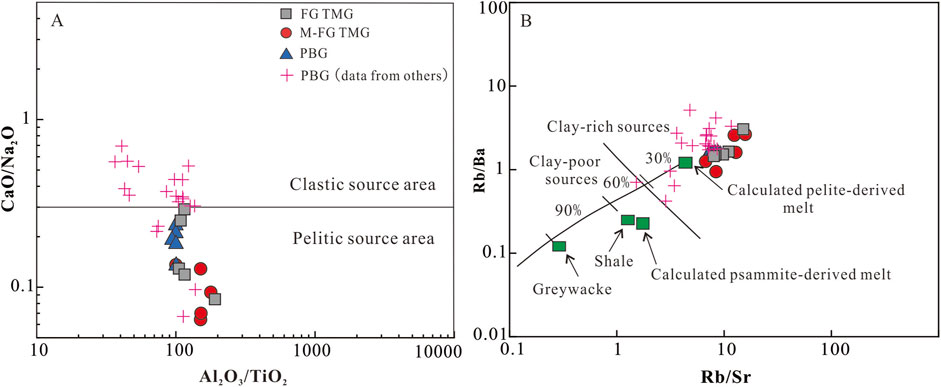
Figure 13. (A) Plot of CaO/Na2O vs. Al2O3/TiO2 (bottom panel according to the study of Sylvester, 1998); (B) plot of Rb/Sr vs. Rb/Ba (bottom panel according to the study of Sylvester, 1998). Other data sources are the same as detailed in Figure 6.
6.4 Tectonic setting
Intense magmatic activity occurred in South China after the Early Jurassic, resulting in multiple stages of tectonic deformation and the formation of large areas of granites, volcanic rocks, and mafic rocks (Mao et al., 2015; Ji et al., 2018; Zhang D. et al., 2018). Many geologists propose that lithosphere extension and thinning, coupled with asthenosphere upwelling, are the main mechanisms responsible for large-scale Mesozoic magmatism in South China (Li et al., 2007; Jiang et al., 2015; 2017; Wang et al., 2015; Xing et al., 2009).
Petrogenetic studies indicate that distinct magma series form in different tectonic environments: shoshonitic rocks typically develop in extensional settings, whereas high-K calc-alkaline magmas are genetically associated with post-collisional processes (Wang et al., 2019). The PBG, M-FG TMG, and FG TMG display transitional geochemical characteristics between high-K calc-alkaline and shoshonitic series, suggesting that their emplacement occurred within a post-collisional extensional regime. This interpretation is further supported by systematic geochemical discriminators, as shown in the Rb vs. Y + Nb and SiO2 vs. Al2O3 tectonic setting diagrams (Figures 14A,B), where all analytical data from PBG, M-FG TMG, and FG TMG consistently plot within the post-collisional field.
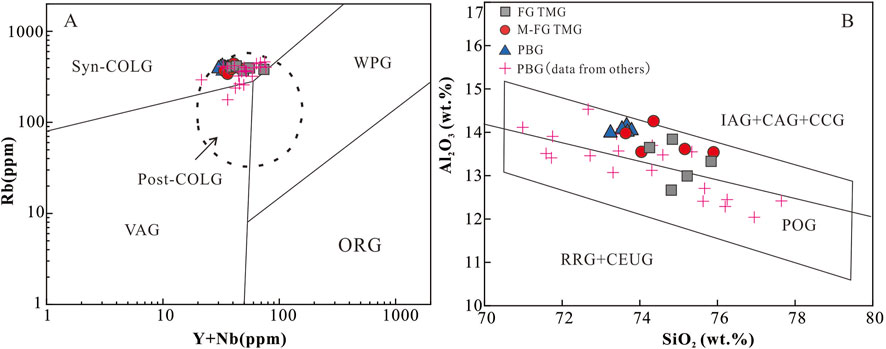
Figure 14. (A) Plot of Y + Nb vs. Rb (bottom panel according to Pearce, 1996); (B) plot of SiO2 vs. Al2O3 (bottom panel according to Maniar and Piccoli, 1989). Syn-COLG, syn-collisional granite; WPG, within-plate granite; VAG, volcanic arc granite; ORG, ocean ridge granite; Post-COLG, post-collisional granites; IAG, island arc granitoid; CAG, continental arc granitoid; CCG, continental collision granitoid; POG, post-orogenic granitoid; RRG, rift-related granitoid; CEUG, continental epeirogenic uplift granitoid. Other data sources are the same as detailed in Figure 6.
Previous studies have demonstrated that the South China plate experienced post-orogenic extension during 160–150 Ma (Hua et al., 2005). Under these tectonic conditions, extensive magma ascent led to the formation of granitic bodies (Hua et al., 2005). The Fogang granitic batholith, comprising PBG, M-FG TMG, and FG TMG, formed during this period and is interpreted as a product of post-collisional extensional tectonics. Post-collisional extensional regime not only caused the formation of widespread granites but also exerted a significant influence on the spatial distribution and geochemical characteristics of uranium mineralization across the region. The lithospheric thinning and asthenospheric upwelling caused by the extensional stress likely played a crucial role in these processes, facilitating the partial melting of crustal materials and generating metaluminous to peraluminous felsic magmas. These magmas crystallized to form S-type granites, which became significant sources for subsequent uranium mineralization. This process may have subsequently been facilitated by tectonic events or regional stress field reorganizations that reactivated pre-existing fractures, creating preferential pathways for hydrothermal fluid migration and ultimately contributing to the genesis of uranium deposits.
6.5 Redox conditions of magmas and implications for uranium mineralization
Zircon trace and rare earth elements can be used to reveal the initial oxidation conditions and temperatures of magma due to their stable chemical properties, which remain unaltered during hydrothermal alteration (Green, 1995; Li et al., 2022). It has been proposed that Y/Ho ratios in zircon can be utilized to assess whether alteration by late-stage hydrothermal fluids has occurred (Zhang et al., 2011; Jiang et al., 2024). The Y/Ho ratios of the zircons from PBG, M-FG TMG, and FG TMG range from 26.5 to 31.3 (Table 2), which fall into the field without hydrothermal alteration (Y/Ho = 24–34), indicating that the zircons in the PBG, M-FG TMG, and FG TMG in this area were unaffected by hydrothermal fluids after their crystallization. Therefore, the oxygen fugacity recorded in zircon grains can serve as a reliable proxy for the whole-rock oxygen fugacity of granites.
Existing studies indicate that magmatic oxygen fugacity is generally insufficient to stabilize uranium in the hexavalent state (U6+), with uranium predominantly occurring as tetravalent U4+. During the early stages of magmatic evolution, U4+ exhibits a weaker oxygen-binding capacity than Si and Al, owing to its lower ionic potential (Chen et al., 2009). Consequently, the formation of uranium oxides is limited, and uranium tends instead to associate with Th4+, Zr4+, and Y3+ to form uranium-bearing accessory minerals, such as monazite, thorite, and zircon. These accessory minerals are notably resistant to alteration during subsequent hydrothermal processes (Hu et al., 2012; Qi et al., 2014; Zhang et al., 2022; Xu et al., 2023).
Progressive magmatic evolution into the middle to late stages induces compositional changes characterized by decreasing temperature and oxygen fugacity, accompanied by increasingly reducing conditions and reduced isomorphous substitution. The consumption of REEs during earlier accessory mineral crystallization establishes geochemical conditions favorable for uranium–oxygen bonding, ultimately leading to the precipitation of uraninite. Crystalline uranium minerals are highly susceptible to alteration by late-stage fluids, which promotes the release of uranium into these fluids, enabling its accumulation and creating favorable conditions for subsequent uranium mineralization (Zhang et al., 2022).
As previously noted, the oxygen fugacity of PBG (lg fO2 = −16.1 to −9.8, with an average of −13.2) is significantly higher than that of M-FG TMG and FG TMG (lg fO2 = −28.6 to −7.8, averaging −18.2). This trend indicates that, as the magma evolved from PBG to M-FG TMG and FG TMG, its oxygen fugacity decreased, thereby promoting the crystallization of uranium in two-mica granites in the form of uraninite. Furthermore, the uranium content in two-mica granites (15.3 ppm) is 0.7 ppm higher than that in PBG (14.6 ppm). The combination of lower oxidation states and higher uranium enrichment in two-mica granites suggests that they likely represent the primary uranium source rocks for the Pajiang uranium deposit. This interpretation is consistent with the prevailing view that two-mica granites constitute major uranium source rocks for granite-type uranium deposits in South China (Li et al., 2023; Tao et al., 2025). Therefore, regions containing two-mica granites should be prioritized in future exploration efforts targeting granite-type uranium mineralization.
7 Conclusion
Based on the major oxide and trace element compositions, ages, and zircon trace-element data of the porphyritic biotite granite and two-mica granites, the following conclusions are drawn:
1. The rock-forming ages of the PBG, M-FG TMG, and FG TMG, as determined by LA-ICP-MS zircon U–Pb dating, are 156.7 ± 0.7 Ma, 155.3 ± 1.6 Ma, and 153.8 ± 1.4 Ma, respectively, indicating a single magmatic event.
2. The PBG of the Fogang granitic batholith features high silicon, alkali, potassium, and aluminum supersaturation; a high fractionation index; low REE contents; and high Rb/Sr ratios, which are characteristic of highly fractionated S-type granites. The source rocks of PBG are a mixture of pelitic and clastic rocks, whereas those of M-FG TMG and FG TMG are pelitic rocks.
3. The oxygen fugacity is the highest in the PBG of the Pajiang area, followed by the M-FG TMG, with the FG TMG exhibiting the lowest values. The M-FG TMG and FG TMG represent potential uranium source rocks. Two-mica granites should be prioritized in future exploration efforts targeting granite-type uranium mineralization.
4. The granites in the Pajiang area, including PBG, M-FG TMG, and FG TMG, are classified as high-K calc-alkaline granites. Their formation is predominantly attributed to post-collisional extensional tectonics.
Data availability statement
The datasets presented in this study can be found in online repositories. The names of the repository/repositories and accession number(s) can be found in the article/supplementary material.
Author contributions
PH: Data curation, Formal Analysis, Investigation, Writing – original draft. W-CD: Conceptualization, Funding acquisition, Project administration, Writing – review and editing. BL: Conceptualization, Data curation, Formal Analysis, Investigation, Writing – review and editing. W-FW: Data curation, Formal Analysis, Investigation, Writing – review and editing. J-MQ: Investigation, Software, Writing – review and editing. LQ: Data curation, Investigation, Methodology, Writing – review and editing.
Funding
The author(s) declare that financial support was received for the research and/or publication of this article. This study was supported by the National Natural Science Foundation of China (Grant No. 42372263), the “Revelation and Command” project of the Natural Uranium Industry Technology Innovation Consortium (Grant No. 202303), and the Open Fund of the Shanghai Sheshan National Field Scientific Observation and Research Station of Geophysics (Grant No. SSOP202401).
Acknowledgments
The authors are grateful to Prof. Hao Song, Chengdu University of technology, for his valuable suggestions and assistance during the preparation of this manuscript.
Conflict of interest
Authors PH, BL, and J-MQ were employed by Research Institute No. 290, China National Nuclear Corporation. Author WW was employed by Research Institute of Shaanxi Yanchang Petroleum (Group) Co., Ltd.
The remaining authors declare that the research was conducted in the absence of any commercial or financial relationships that could be construed as a potential conflict of interest.
Generative AI statement
The author(s) declare that no Generative AI was used in the creation of this manuscript.
Any alternative text (alt text) provided alongside figures in this article has been generated by Frontiers with the support of artificial intelligence and reasonable efforts have been made to ensure accuracy, including review by the authors wherever possible. If you identify any issues, please contact us.
Publisher’s note
All claims expressed in this article are solely those of the authors and do not necessarily represent those of their affiliated organizations, or those of the publisher, the editors and the reviewers. Any product that may be evaluated in this article, or claim that may be made by its manufacturer, is not guaranteed or endorsed by the publisher.
References
Ballard, J. R., Palin, M. J., and Campbell, I. H. (2002). Relative oxidation states of magmas inferred from Ce (IV)/Ce (III) in zircon: application to porphyry copper deposits of Northern Chile. Contrib. Mineral. petrol. 144 (3), 347–364. doi:10.1007/s00410-002-0402-5
Bao, Z. W., and Zhao, Z. H. (2003). Geochemistry and tectonic setting of the Fogang aluminous A-type granite, Guangdong province, China- A preliminary study. Geol. – Geochem (Guiyang, China) 31 (1), 52–61. doi:10.3969/j.issn.1672-9250.2003.01.009
Barth, M. G., McDonough, W. F., and Rndnick, R. L. (2000). Tracking the budget of Nb and Ta in the continental crust. Chem. Geol. 165, 197–213. doi:10.1016/S0009-2541(99)00173-4
Chabiron, A., Cuney, M., and Poty, B. (2003). Possible uranium sources for the largest uranium district associated with volcanism: the Streltsovka caldera (Transbaikalia, Russia). Min. Depos. 38, 127–140. doi:10.1007/s00126-002-0289-0
Chappell, B. W. (1999). Aluminium saturation in I- and S-type granites and the characterization of fractionated haplogranites. Lithos 46, 535–551. doi:10.1016/S0024-4937(98)00086-3
Chen, J. Y., and Yang, J. H. (2015). Petrogenesis of the Fogang highly fractionated I-type granitoids: constraints from Nb, Ta, Zr and Hf. Acta Petrol. Sin. 31 (3), 846–854.
Chen, X. M., Wang, R. C., Liu, C. S., Hu, H., Zhang, W. L., and Gao, J. F. (2002). Isotopic dating and genesis for Fogang biotite granites of Conghua area, Guangdong Province. Geol. J. China Univ. 8, 293–307. doi:10.16108/j.issn1006-7493.2002.03.006
Chen, Y. W., Bi, X. W., Hu, R. Z., and Qi, H. W. (2009). Comparison of geochemical characteristic of uranium and non-uranium-bearing indosinian granites in Guidong composite pluton. J. Mineral. Petrol. 29, 106–114. doi:10.1360/972008-2143
Cuney, M. (2009). The extreme diversity of uranium deposits. Min. Depos. 44, 3–9. doi:10.1007/s00126-008-0223-1
Cuney, M. (2014). Felsic magmatism and uranium deposits. Bull. Soc. Geol. Fr. 185 (2), 75–92. doi:10.2113/gssgfbull.185.2.75
Ding, X., Su, K. L., Yan, H. B., Liang, J. L., and Sun, W. D. (2022). Effect of F-rich fluids on the A-type magmatism and related metal mobilization: new insights from the Fogang-Nankunshan-Yajishan igneous rocks in southeast China. J. Earth Sci. 33 (3), 591–608. doi:10.1007/s12583-022-1611-7
Fan, H. H., Pang, Y. Q., He, D. B., Chen, D. H., Wang, Y. J., Sun, Y. Q., et al. (2023). Metallogenic process and prediction of granite-related uranium deposits in south China. Acta Geosci. Sin. 44 (5), 887–896. doi:10.3975/cagsb.2022.12210
Ferry, J. M., and Watson, E. B. (2007). New thermodynamic models and revised calibrations for the Ti-in-zircon and Zr-in-rutile thermometers. Contrib. Mineral. Petrol. 154 (4), 429–437. doi:10.1007/s00410-007-0201-0
Gao, J. F., Ling, H. F., Sheng, W. Z., Lu, J. J., Zhang, M., Huang, G. L., et al. (2005). Geochemistry and petrogenesis of Lianyang granite composite, west Guangdong province. Acta Petrol. Sin. 21 (6), 1645–1656.
Green, T. H. (1995). Significance of Nb/Ta as an indicator of geochemical processes in the crust mantle system. Chem. Geol. 120, 347–359. doi:10.1016/0009-2541(94)00145-X
Guangdong Bureau of geology and mineral resources, Team No.705 (1983). Geological survey and evaluation report on uranium deposits in the Shengping-Longshan segment of the Fogang No.261 area, Qingyuan, Guangdong Province, China (Unpublished report).
Guo, M., and Huang, K. W. (2019). Geochemistry, chronology and geological significance of medium grain porphyritic granite in the Fogang intrusion, northern Guangdong. Geol. Min. Resour. South China 35 (2), 158–170. doi:10.3969/j.issn.1007-3701.2019.02.003
Hu, H., Wang, R. C., Chen, W. F., Ding, H. H., Chen, P. R., and Ling, H. F. (2012). Study on uranium resource minerals of Douzhashan uranium-bearing granite, Northeastern Guangxi. Geol. Rev. 58 (6), 1056–1068. doi:10.16509/j.georeview.2012.06.002
Hu, Z. C., Zhang, W., Liu, Y. S., Gao, S., Li, M., Zong, K. Q., et al. (2015). The assembly of Rodinia: the correlation of early Neoproterozoic (ca.900 Ma) high-grade metamorphism and continental arc formation in the southern Beishan Orogen, southern Central Asian Orogenic Belt (CAOB). Precambrian Res. 290, 32–48. doi:10.1016/j.precamres.2016.12.010
Hua, R. M., Chen, P. R., Zhang, W. L., Yao, J. M., Lin, J. F., Zhang, Z. S., et al. (2005). Metallogeneses and their geodynamic settings related to Mesozoic granitoids in the Nanling range. Geol. J. China Univ. 11 (3), 291–304. doi:10.3969/j.issn.1006-7493.2005.03.002
Jayananda, M., Moyen, J. F., Martin, H., Peucat, J.-J., Auvray, B., and Mahabalesawar, B. (2000). Late Archaean (2550-2520 Ma) juvenile magmatism in the eastern Dharwar craton, southern India: constraints from geochronology, Nd-Sr isotopes and whole rock geochemistry. Precamb. Res. 99, 225–254. doi:10.1016/S0301-9268(99)00063-7
Ji, W. B., Chen, Y., Chen, K., Wei, W., Faure, M., and Lin, W. (2018). Multiple emplacement and exhumation history of the late mesozoic dayunshan-mufushan batholith in southeast China and its tectonic significance: 2. Magnetic fabrics and gravity survey. J. Geophys. Res. Solid Earth 123, 711–731. doi:10.1002/2017JB014598
Jiang, Y. H., Wang, G. C., Liu, Z., Ni, C. Y., Qing, L., and Zhang, Q. (2015). Repeated slab advance–retreat of the Palaeo-Pacific plate underneath SE China. Int. Geol. Rev. 57 (4), 472–491. doi:10.1080/00206814.2015.1017775
Jiang, Y. H., Wang, G. C., Qing, L., Zhu, S. Q., and Ni, C. Y. (2017). Early jurassic A-type granites in southeast China: shallow dehydration melting of early paleozoic granitoids by basaltic magma intraplating. J. Geol. 125 (3), 351–366. doi:10.1086/691242
Jiang, K. N., Luo, J. C., Zhong, F. J., Liu, G. Q., Zhang, X. T., and Jiang, X. Y. (2024). Zircon oxygen fugacity as a tracer to distinguish the parent rock volcanic-hosted uranium mineralization in the Xiangshan area, South China. Acta Geol. Sin. 98 (1), 181–199. doi:10.19762/j.cnki.dizhixuebao.2023019
King, P. L., White, A. J. R., Chappell, B. W., and Allen, C. M. (1997). Characterization and origin of aluminous A-type granites from the lachlan fold belt, southeastern Australia. J. Petrol. 38 (3), 371–391. doi:10.1093/petroj/38.3.371
Lan, H. F., Wang, H. Z., Ling, H. F., Chen, W. F., Wang, K. X., and Wang, D. (2020). Petrogenesis of the Chashan granite in the northern Guangdong province and its implication for the metallogenic potential of tungsten and uranium mineralization. Acta Geol. sin. 94 (4), 1143–1165.
Li, X. H., Li, Z. X., Liu, Y., Yuan, C., Wei, G. J., Qi, C. S., et al. (2007). U-Pb zircon, geochemical and Sr-Nd-Hf isotopic constraints on age and origin of Jurassic I-and A-type granites from central Guangdong, SE China: a major igneous event in response to foundering of a subducted flat-slab? Lithos 96, 186–204. doi:10.1016/j.lithos.2006.09.018
Li, H., Watanabe, K., and Yonezu, K. (2014). Zircon morphology, geochronology and trace element geochemistry of the granites from the Huangshaping polymetallic deposit, South China: implications for the magmatic evolution and mineralization processes. Ore Geol. Rev. 60, 14–35. doi:10.1016/j.oregeorev.2013.12.009
Li, J., Huang, H. Y., Liu, Z. J., Zhang, T., Wang, Q. L., Fang, S. Y., et al. (2021). La-ICP-MS U-Pb ages and trace element compositions of zircon from indosinian granites in middle Zhuguangshan. Geotecton. Metallog. 45 (6), 1216–1232. doi:10.16539/j.ddgzyckx.2021.06.007
Li, S. K., Liu, X. L., Lu, Y. X., Zhang, S. T., Liu, S. H., Chen, J. H., et al. (2022). Indication of zircon oxygen fugacity to different mineralization control factors of porphyry deposits in Zhongdian ore-concentrated area, Southern Yidun Arc. Earth Sci. 47 (04), 1435–1458. doi:10.3799/dqkx.2021.079
Li, K., Chen, W. F., Gao, S., Shen, W. Z., Huang, G. L., Liu, W. Q., et al. (2023). The petrogenesis of Baishuizhai granitic pluton and its significance to uranium mineralization in the Xiazhuang area, Guangdong province[J]. Geol. J. China Univ. 29 (4), 497–513. doi.doi:10.16108/j.issn1006-7493.2021117
Li, H. D., Jiang, W. B., Liu, B., Lai, J., and Guo, X. W. (2024a). Geological characteristics and prospecting potential of uranium mineralization in the south of Zhuguang pluton. Uran. Geol. 40 (3), 442–458. doi:10.3969/j.issn.1000-0658.2024.40.039
Li, H. D., Tian, S. H., Liu, B., Hu, P., Wu, J. Y., and Chen, Z. L. (2024b). In-situ microchronology and elemental analysis of pitchblende in the Pajiang uranium deposit, northern Guangdong: implication for uranium mineralization. Earth Sci. Front. 31 (2), 270–283. doi:10.13745/j.esf.sf.2023.11.70
Ling, H. F., Shen, W. Z., Sun, T., Jiang, S. Y., Jiang, Y. H., Ni, P., et al. (2006). Genesis and source characteristics of 22 Yanshanian granites in Guangdong province: study of element and Nd-Sr isotopes. Acta Petrol. Sin. 22 (11), 2687–2703.
Ludwig, K. R. (2003). Isoplot 3.0: a geochronological toolkit for microsoft excel. California, Berkeley: Berkeley Geochronology Center, 39.
Maniar, P. D., and Piccoli, P. M. (1989). Tectonic discrimination of granitoids. Geol. Soc. Am. Bull. 101 (5), 635–643. doi:10.1130/0016-7606(1989)101<0635:TDOG>2.3.CO;2
Mao, J. R., Li, Z. L., and Ye, H. M. (2015). Mesozoic tectono-magmatic activities in South China: retrospect and prospect. Sci. China Earth Sci. 57 (12), 2853–2877. doi:10.1007/s11430-014-5006-1
Mcdonough, W. F., Sun, S. S., Ringwood, A. E., Jagoutz, E., and Hoffmann, A. W. K. (1991). K, Rb and Cs in the earth and moon and the evolution of the earth's mantle. Geochim. Cosmochim. Acta., 68–76. doi:10.1016/0016-7037(92)90043-I
Middlemost, E. A. K. (1985). Magmas and magmatic rocks: an introduction to igneous petrology. London: Longman, 1–226. doi:10.1180/minmag.1986.050.355.34
Middlemost, E. A. K. (1994). Naming materials in the magma/igneous rock system. Earth-Sci. Rev. 37 (3-4), 215–224. doi:10.1016/0012-8252(94)90029-9
Pearce, J. A. (1996). Sources and settings of granitic rocks. Episodes 19 (4), 120–125. doi:10.18814/epiiugs/1996/v19i4/005
Qi, J. M., Huang, G. L., Zhu, B., Fu, S. C., Xu, Y., and Ye, S. X. (2014). Compositions study of auxiliary minerals in altered granitic rocks of the Mianhuakeng uranium deposit in Northern Guangdong. Acta Geol. Sin. 88 (9), 1691–1704. doi:10.19762/j.cnki.dizhixuebao.2014.09.006
Qiu, L., Yan, D. P., Tang, S. L., Arndt, N. T., Fan, L. T., Guo, Q. Y., et al. (2015). Cooling and exhumation of the oldest Sanqiliu uranium ore system in Motianling district, South China Block. Terra nova. 27 (6), 449–457. doi:10.1111/ter.12179
Qiu, L., Yan, D. P., Ren, M., Cao, W., Tang, S. L., Guo, Q. Y., et al. (2018). The source of uranium within hydrothermal uranium deposits of the Motianling mining district, Guangxi, South China. Ore Geol. Rev. 96, 201–217. doi:10.1016/j.oregeorev.2018.04.001
Shu, L. S., Zhou, X. M., Deng, P., and Yu, X. Q. (2006). Principal geological features of Nanling tectonic belt, South China. Geol. Rev. 52, 251–265. doi:10.1016/S1001-8042(06)60011-0
Sun, X. S., and Mcdonough, W. F. (1989). “Chemical and isotopic systematics of oceanic basalts: implications for mantle composition and processes,” Isotopic Syst. Ocean. basalts Implic. mantle Compos. Process. (London: Geological Society), 42. 313–345. doi:10.1144/GSL.SP.1989.042.01.19
Sylvester, P. J. (1998). Post-collisional strongly peraluminous granites. Lithos 45, 29–44. doi:10.1016/S0024-4937(98)00024-3
Tao, J. H., Yang, Y. G., Su, X. Y., Leng, C. B., Li, K. X., Chen, X. L., et al. (2025). Petrogenesis of U-rich two-mica granite from the Mesozoic Reshui pluton (Nanling Range, South China) with implications for uranium mineralization. J. Asian Earth Sci. 277, 106400. doi:10.1016/j.jseaes.2024.106400
Taylor, S. R., and McLennan, S. M. (1995). The geochemical evolution of the continental crust. Rev. Geophys. 33 (2), 241–265. doi:10.1029/95RG00262
Trail, D., Watson, E. B., and Tailby, N. D. (2011). The oxidation state of Hadean magmas and implications for early Earth's atmosphere. Nature 480, 79–82. doi:10.1038/nature10655
Trail, D., Watson, E. B., and Tailby, N. D. (2012). Ce and Eu anomalies in zircon as proxies for the oxidation state of magmas. Geochim. Cosmochim. Acta. 97, 70–87. doi:10.1016/j.gca.2012.08.032
Wang, Q., Zhu, D. C., Zhao, Z. D., Guan, Q., Zhang, X. Q., Sui, Q. L., et al. (2012). Magmatic zircons from I-S- and A-type granitoids in Tibet: trace element characteristics and their application to detrital zircon provenance study. J. Asian Earth Sci. 53, 59–66. doi:10.1016/j.jseaes.2011.07.027
Wang, L. X., Ma, C. Q., Lai, Z. X., Marks, M. A. W., Zhang, C., and Zhong, Y. F. (2015). Early Jurassic mafic dykes from the Xiazhuang ore district (South China): implications for tectonic evolution and uranium metallogenesis. Lithos 239, 71–85. doi:10.1016/j.lithos.2015.10.008
Wang, T., Guo, L., Li, S., Wang, X. X., and Wang, C. Y. (2019). Some important issues in the study of granite tectonics. J. Geomech. 25 (5), 899–919. doi:10.12090/j.issn.1006-6616.2019.25.05.074
Whalen, J. B., Carrie, K. L., and Chappell, B. W. (1987). A-type granites: geochemical characteristics, discrimination and petrogenesis. Contrib. Mineral. Petrol. 95, 407–417. doi:10.1007/BF00402202
Wu, F. Y., Guo, C. L., Hu, F. Y., Liu, X. C., Zhao, J. X., Li, X. F., et al. (2023). Petrogenesis of the highly fractionated granites and their mineralizations in Nanling range, South China. Acta Petrol. Sin. 39 (01), 1–36. doi:10.18654/1000-0569/2023.01.01
Xin, H. B., and Qu, X. M. (2008). Relative oxidation states of ore-bearing porphyries inferred from Ce(Ⅳ)/Ce(Ⅲ) ratio in zircon: application to the porphyry copper belt at Gangdese, Tibet. Acta Mineral. Sin. 28 (2), 152–160.
Xing, J. S., Yang, W. R., Xing, Z. Y., Liu, J. H., and Shao, J. S. (2009). Meso-Cenozoic asthenosphere upwelling of eastern China and its impacts on structure-magma-mineralization concentration region. Earth Sci. Front. 16 (4), 225–239. doi:10.1016/S1874-8651(10)60080-4
Xu, L. L. (2024). Fault characteristics and uranium prospecting direction in Pajiang area of Fogang pluton in northern Guangdong. Uran. Geol. 40 (3), 428–441. doi:10.3969/j.issn.1000-0658.2024.40.038
Xu, X. S., Lu, W. M., and He, Z. Y. (2007). Age and generation of Fogang granite batholith and Wushi diorite-horblende gabbro body. Sci. China Earth Sci. 37 (1), 27–38. doi:10.1007/s11430-007-2068-3
Xu, W. T., Zhang, X. H., Zhang, B. B., Lv, J. S., Sun, J. D., Zhang, Y., et al. (2022). Genesis of highly fractionated S-type granites: evidence from zircon U-Pb geochronology, Hf isotopes and geochemistry of Fuquanshan pluton, northeastern Jiangxi province. Geol. Bull. China. 41, 577–589. doi:10.12097/j.issn.167-2552.2022.04.005
Xu, P. L., Tang, X. S., Guo, F. S., Lv, C., Li, G. R., Dang, F. P., et al. (2023). Characteristics and geological significance of chorite from the cataclastic alteration granite-type uranium deposit in Lujing ore field, south China: perspective from Xiaoshan deposit. Acta Geol. Sin. 97 (2), 1211–1227. doi:10.19762/j.cnki.dizhixuebao.2023221
Yang, F., Han, H. W., Bian, T. Y., Yuan, X. J., Guo, X. F., Zou, D. H., et al. (2024). Identification of zircons of different origin in complex rock mass and its implications for zircon U-Pb age: a case study from zircon of Archean basement in Liaohe Depression. Chin. J. Geol. 59 (5), 1308–1325. doi:10.12017/dzkx.2024.092
Zhang, H., Sun, W. D., and Yang, X. Y. (2011). Chronology and metallogenic mechanism of the shapinggou super large porphyry Molybdenum deposit in the Dabie orogenic belt. Acta Geol. Sin. 85 (12), 2039–2059.
Zhang, L., Chen, Z. Y., Li, X. F., Li, S. R., Santosh, M., and Huang, G. L. (2018a). Zircon U-Pb geochronology and geochemistry of granites in the Zhuguangshan complex, South China: implications for uranium mineralization. Lithos 308-309, 19–33. doi:10.1016/j.lithos.2018.03.012
Zhang, D., Zhao, K. D., Chen, W., and Jiang, S. Y. (2018b). Early Jurassic mafic dykes from the Aigao uranium ore deposit in South China: geochronology, petrogenesis and relationship with uranium mineralization. Lithos 308-309, 118–133. doi:10.1016/j.lithos.2018.02.028
Zhang, C., Cai, Y. Q., Dong, Q., Xu, H., and He, S. (2019). Genesis of the South Zhuguang uranium ore field, South China: fluid inclusion and H-C-O-S-Sr isotopic constraints. Appl. Geochem. 100, 104–120. doi:10.1016/j.apgeochem.2018.11.008
Zhang, L., Chen, Z., Wang, F., White, N. C., and Zhou, T. (2021a). Release of uranium from uraninite in granites through alteration: implications for the source of granite-related uranium ores. Econ. Geol. Bull. Soc. Econ. Geol. 116 (5), 1115–1139. doi:10.5382/econgeo.4822
Zhang, L., Chen, Z. Y., and Wang, F. Y. (2021b). General characteristics and research progress in metallogenies of granite-related uranium deposits in South China. Acta Petrol. Sin. 37 (9), 2657–2676. doi:10.18654/1000-0569/2021.09.04
Zhang, L., Wang, F. Y., Zhou, T. F., and Chen, Z. Y. (2022). Contrasting U-Pb geochronology and geochemistry of uraninite from the Xianshi and Xiwang uranium deposits, South China: implications for ore genesis. Ore Geol. Rev. 149, 105120–15. doi:10.1016/j.oregeorev.2022.105120
Zhou, X. M. (2007). The genesis and petrogenesis of late Mesozoic granites in the Nanling area and the dynamics of the lithosphere evolution. Beijing: Science Press.
Zhu, J. C., Chen, J., Wang, R. C., Lu, J. J., and Xie, L. (2008). Early Yanshanian NE trending Sn/W-bearing A-type granites in the western-middle part of the Nanling Mts region. Geol. J. China Univ. 14 (4), 474–484. doi:10.3969/j.issn.1006-7493.2008.04.002
Keywords: Fogang granitic batholith, zircon U–Pb dating, S-type granites, whole-rock geochemistry, uranium source, Pajiang area
Citation: Hu P, Ding W-C, Liu B, Wei W-F, Qi J-M and Qiu L (2025) Geochronology and geochemistry of the Fogang granitic batholith and its implications for uranium mineralization. Front. Earth Sci. 13:1588243. doi: 10.3389/feart.2025.1588243
Received: 05 March 2025; Accepted: 29 August 2025;
Published: 29 September 2025.
Edited by:
Abderrahmane Bendaoud, University of Science and Technology Houari Boumediene, AlgeriaReviewed by:
Yinhang Cheng, China Geological Survey, ChinaMohamed Faisal, Suez Canal University, Egypt
Copyright © 2025 Hu, Ding, Liu, Wei, Qi and Qiu. This is an open-access article distributed under the terms of the Creative Commons Attribution License (CC BY). The use, distribution or reproduction in other forums is permitted, provided the original author(s) and the copyright owner(s) are credited and that the original publication in this journal is cited, in accordance with accepted academic practice. No use, distribution or reproduction is permitted which does not comply with these terms.
*Correspondence: Wei-Cheng Ding, MTc4MTc3MTdAcXEuY29t; Bin Liu, MTM5NTE2NTE4ODJAMTYzLmNvbQ==
 Peng Hu
Peng Hu Wei-Cheng Ding1,2*
Wei-Cheng Ding1,2* Bin Liu
Bin Liu Liang Qiu
Liang Qiu